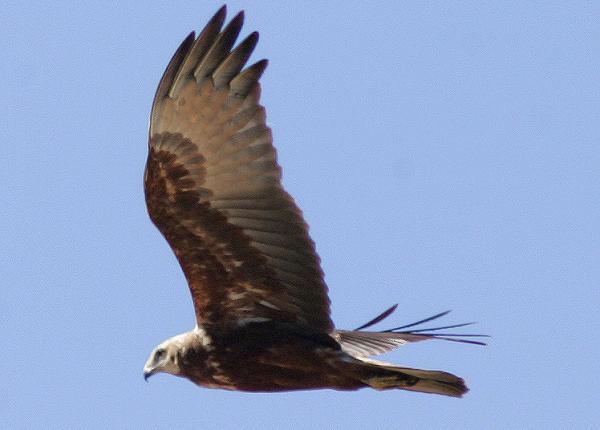Did You Know?
- Even though the Papuan Harrier is classified as a species of Least Concern, some researchers argue it should be listed as Vulnerable because of the threats it is facing.
- The Papuan Harrier can be seen roosting in small groups of 4-5 individuals.
How The Peregrine Fund is Helping
Though The Peregrine Fund doesn't work directly with Papuan Harriers, our efforts in scientific research, habitat conservation, education, and community development help conserve raptors around the world. We also supply literature to researchers from our avian research library, which helps scientists around the world gather and share important information on raptor conservation.
Where They Live
The Papuan Harrier is endemic to central and eastern New Guinea. It spends most of its time in open areas including large grasslands, floodplains, and wetlands. Some researchers even observed it hunting near buildings and towns as well as near traditional villages in the highlands.
What They Do
The Papuan Harrier comes in two color morphs: light and dark. This means exactly what you would guess it to mean - some individuals have lighter coloration while others are more dark all over. The light morph adult male has a black head, throat and back. Its body is an overall light gray and have black markings on its wings. Its underparts are white. The adult female is overall brown in color. Her tail is barred and her underparts are mottled.
The juvenile Papuan Harrier is darker brown overall with off-white streaking on the head.
The dark morph male of this species is overall black in color. It has a grey tail. The female is dark brown.
Two researchers studying this species back in the 1960's (Rand and Gilliard) stated that it is wary and difficult to approach.
Because the Papuan Harrier often hunts over grasslands and other areas where small prey may be well-hidden, it must rely on its hearing to help it pinpoint prey.
It is one of the relatively few diurnal raptors that have a facial disk, a trait shared with owls. The facial disk is composed of feathers that form a circle around the bird’s face. The disk can be lifted or lowered at will. When the feathers of the facial disk are raised, they help direct sounds to the birds’ ears, which are located on the sides of its head. To find out how this works, cup your hands behind your ears and listen. You might notice that whatever you are listening to seems louder.
Why They Need our Help
The Papuan Harrier is classified as Least Concern by the IUCN. However, this doesn't mean that it doesn't face many threats. For example, one major threat the species faces is the purposeful burning of grasslands and cane fields prior to the end of dry season. Since the harriers choose these areas for nesting, their nests are often destroyed in these fires.
What They Eat
The Papuan Harrier feeds mainly on small mammals (rats and mice), lizards, frogs, birds and bird eggs. Specifically, it has been documented feeding on quail (Coturnix sp.) and their nest contents, Lewin's Rail (Rallus pectoralis), mannikins (Lonchura sp.) and Pied Chat (Saxicola caprata) or Willie Wagtail (Rhipidura leucophrys). Scientists estimate that over 70% of their diet is made up of birds.
One researcher suggested that they might spend some time around airstrips searching for dead or injured amphibians.
This species typically flies about 4-5 m above grasslands and wheels and stoops on prey, rather than striking rapidly from lower altitudes like other harriers.
One researcher observed these harriers foraging over semi-burned grassland and thought that they were attracted to burning areas along with Black Kites. You might be wondering why any animal would be attracted to fire when most animals would be fleeing it. Well, inside the question lies the answer! Harriers and other raptors frequent burning grasslands as they can sometimes catch birds, mammals and other animals as they attempt to escape the fire.
Nests, Eggs and Young
Similar to other harriers, the Papuan Harrier is a ground-nester. During the breeding season, nests are often placed among reeds that can provide shade and visual barrier to the nest. These harriers can lay up to at least three eggs.
The Papuan Harrier and the World Center for Birds of Prey
The World Center for Birds of Prey offers fun ways to learn about all birds of prey. Interactive activities, tours, interesting videos, and a children's room with activities from coloring sheets to quizzes to costumes await you. The visitor center has many live raptors on display. This is a great chance to see birds of prey up close and learn about the wonderful and interesting adaptations they have in order to survive in their respective habitats. There is also a touch table with feathers and other natural objects available for exploration
Though the World Center for Birds of Prey is very far from where the Papuan Harrier lives, the Northern Harrier is found in Idaho and can often been seen flying low above the hills surrounding the center.
Resources:
BirdLife International 2016. Circus spilothorax . The IUCN Red List of Threatened Species 2016: e.T61709172A95177943. https://dx.doi.org/10.2305/IUCN.UK.2016-3.RLTS.T61709172A95177943.en.
del Hoyo, J., N. Collar, and J. S. Marks (2020). Papuan Marsh-Harrier (Circus spilothorax), version 1.0. In Birds of the World (J. del Hoyo, A. Elliott, J. Sargatal, D. A. Christie, and E. de Juana, Editors). Cornell Lab of Ornithology, Ithaca, NY, USA. https://doi.org/10.2173/bow.easmah2.01
Simmons, R.E. and Legra, L.A., 2009. Is the Papuan Harrier Circus spilonotus spilothorax a globally threatened species? Ecology, climate change threats and first population estimates from Papua New Guinea. Bird Conservation International, 19(4), pp.379-391.









